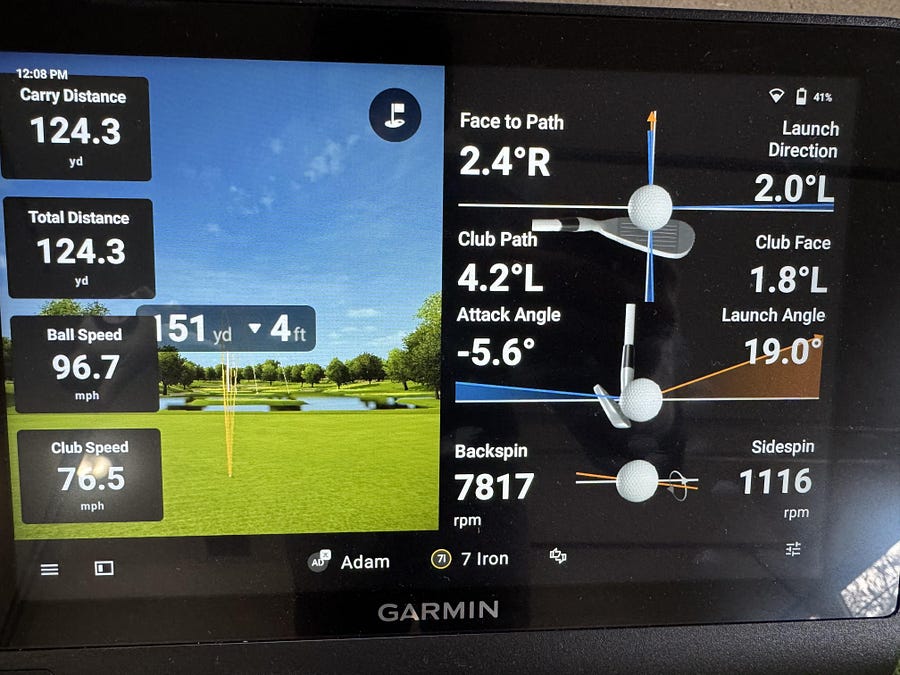I’ve used everything from the R10 to the GCQuad, and I didn’t think Garmin had much more to offer. But then I got my hands on the $4,999 plus tax Garmin Approach R50 . After a few weeks of testing it in my garage setup and in a pro swing studio, I’ll be honest. This is easily one of the most impressive products I’ve tried in a long time.
This thing isn’t just a launch monitor. It’s a full simulator with a 10 inch built in touchscreen, 15 different shot metrics, and the ability to play real courses without plugging into third party software. You set it down, turn it on, and you’re ready to go in minutes. That’s not just convenient. That’s rare in this space.
The first thing I noticed was the size. It’s definitely bigger than the R10, and it’s not the kind of thing you toss in your bag for a casual trip to the range. But it’s surprisingly light for its size, and the carrying case is solid. You can move it around if you need to. It’s just better suited for a more permanent indoor setup. I had mine up and running in less than five minutes.
What stood out right away was the screen. It’s super sharp, touch responsive, and has an intuitive layout that doesn’t overwhelm you with buttons or menus. I connected it to WiFi, logged into my Garmin Golf account, and everything synced automatically. Clubs, settings, session history, all of it. I could jump between practice mode, full simulator play, or external software like GSPro if I wanted to. It felt polished, not clunky.
The Practice Mode is where I spent most of my time. There are multiple ways to customize the screen. You can toggle data fields on or off, change view angles, and mirror the display to a projector. I used the HDMI port to run mine on a hitting bay screen, and it looked great.
Once you hit a shot, the feedback is instant. Ball speed, club path, launch angle, spin, carry, total distance, face angle. All the numbers you’d expect from a much more expensive unit. And everything looked spot on compared to what I’m used to seeing from higher end monitors.
What I didn’t expect was the impact video playback. Every shot gets a slow motion replay of the exact moment your club hits the ball. You can drag the slider and analyze spin, face contact, and ball behavior in a way that’s actually useful. Especially on wedge shots where spin and face control matter most. It’s not just cool to watch. It helps you learn.
On the simulator side, it’s got 43,000 courses available with a subscription through Home Tee Hero. I tested out Pebble Beach, and it was about as immersive as you can get at this price. The graphics looked good, ball flights were accurate, and the built in screen gave me a top down view of each hole while the projector displayed the gameplay. I loved being able to aim using the touchscreen and plan out shots like I would on a real course.
Now, you will need to pay a monthly or annual subscription to unlock the full simulator features. I paid about $10 a month, which is nothing compared to what others charge for third party course access. Considering the quality of the Home Tee Hero platform and how far it’s come since the R10 days, I think it’s a fair deal.
I also liked how you can take notes after each swing. Say you’re working on keeping your hands ahead of the ball at impact. You can type in a reminder or observation and see how that lines up with the shot data. It’s small, but that kind of detail helps make your practice smarter.
There are a few things to know, though. First, this is meant to be an indoor only setup. You’ll need a hitting net, mat, and enough space to safely take full swings. You can use it outdoors as well. It won’t track well outdoors though, and Garmin makes that clear. Second, the unit connects directly to a projector with HDMI, not a laptop. That’s great because it keeps things simple, but it also means you’ll be bending down to interact with the screen if it’s on the floor. If you’ve got bad knees or a tight space, that might get annoying.
Also, while the device itself is around $3,000 to $4,000 depending on where you get it, you still need to factor in the rest of the setup. A good enclosure, screen, projector, and hitting mat will run you at least another $1,000 or more. So while this is all in one in terms of tech, you’re still going to need to build out your hitting area.
Battery life is solid. I got close to four hours on one charge, though I usually had it plugged in. For most people, that’s more than enough to run a full range session or play 18 holes.
Overall, though. The Garmin Approach R50 is the real deal. It’s accurate. It’s easy to use. It’s built for serious golfers who want real data and an immersive simulator without the mess of a complicated setup. The interface is miles ahead of other monitors in this price range, and the fact that you can get started without third party software makes it more beginner friendly than it gets credit for.
If you’ve got the space and you’re looking for a system that can track your swing and let you play real rounds from home, this one’s hard to beat. I honestly didn’t think Garmin would make something this good, but they nailed it.






